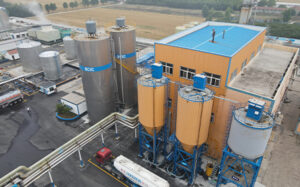Einführung
Polyvinylidene Fluoride, commonly referred to as PVDF, is a polymer that stands at the intersection of science and innovation. In this comprehensive article, we embark on a journey into the world of PVDF, unraveling its intricate chemistry, exploring its diverse properties, and delving into its myriad applications.
Understanding the Basics

Die Chemie hinter PVDF
PVDF, or Polyvinylidene Fluoride, is a thermoplastic fluoropolymer with a distinctive chemical composition. Its molecular structure consists of carbon (C) and fluorine (F) atoms arranged in a repeating pattern of CH2-CF2 units. This unique arrangement is the secret behind many of PVDF’s exceptional properties.
Properties that Set PVDF Apart
PVDF boasts an impressive array of properties that make it a standout material in the world of polymers:
1. Chemische Resistenz
PVDF is highly resistant to a wide range of chemicals, acids, and solvents. This exceptional chemical inertness makes it an ideal choice for applications where exposure to corrosive substances is a concern.
2. Mechanische Festigkeit
The semi-crystalline nature of PVDF contributes to its excellent mechanical strength and stiffness. It can withstand mechanical stress and deformation, making it suitable for demanding applications.
3. Thermische Stabilität
PVDF exhibits remarkable thermal stability, with a broad temperature range for usability. It can perform in extreme conditions, from sub-zero temperatures to elevated heat.
4. Piezoelektrizität
One of PVDF’s most fascinating properties is its piezoelectricity. When subjected to mechanical stress or pressure, PVDF generates an electric charge. This property finds applications in sensors, actuators, and electronic devices.
Forms and Varieties
PVDF is available in various forms, each tailored to specific applications:
– Sheets and Films
PVDF sheets and films are commonly used in architectural applications, such as cladding and roofing, due to their weather resistance and durability.
– Fibers
PVDF fibers are utilized in textiles and filtration systems, where chemical resistance and strength are paramount.
– Powders
PVDF powders are used in manufacturing processes, including coatings and adhesives, owing to their ease of dispersion and application.
Historical Evolution

Early Discoveries
The history of PVDF traces its roots to the mid-20th century when chemists first began exploring the potential of vinylidene fluoride (VDF) monomers. Here are the key milestones:
– 1940s: Initial Research
The 1940s saw the synthesis of VDF monomers, laying the foundation for PVDF’s eventual discovery.
– 1950s: Polymerization
In the 1950s, researchers successfully polymerized VDF monomers, resulting in the creation of PVDF. Its outstanding properties started to emerge.
Commercialization and Diverse Applications
The 1960s marked the beginning of PVDF’s commercialization, as manufacturing processes were refined. Its versatility led to its adoption in various industries:
– 1960s: Commercialization
PVDF production on a commercial scale commenced in the 1960s, making it more readily available for industrial use.
– 1970s: Expansion into Industries
During the 1970s, PVDF began to find its place in industries such as aerospace, electronics, and chemical processing, thanks to its exceptional properties.
Modern-Day Applications
PVDF’s journey continued into the modern era, where it became a linchpin in the development of groundbreaking technologies:
– 1990s and Beyond
In recent decades, PVDF has played a crucial role in the development of lithium-ion batteries, water purification membranes, architectural coatings, and more.
Fazit
Polyvinylidene Fluoride (PVDF) is a material of boundless potential, forged through decades of scientific exploration and innovation. Its unique combination of chemical resistance, mechanical strength, thermal stability, and piezoelectricity has propelled it into the forefront of various industries. As we conclude our exploration of PVDF, we stand on the precipice of further discoveries and applications, where this remarkable polymer continues to shape the future.
Häufig gestellte Fragen (FAQ)
1. What are the key properties of PVDF?
PVDF possesses exceptional chemical resistance, mechanical strength, thermal stability, and piezoelectricity. These properties make it highly versatile in a multitude of applications.
2. What is the chemical structure of PVDF?
PVDF’s chemical structure consists of repeating CH2-CF2 units, comprised of carbon (C) and fluorine (F) atoms, which contribute to its remarkable properties.
3. In which industries is PVDF commonly used?
PVDF finds its application in diverse industries, including aerospace, electronics, chemical processing, water purification, architecture, and more.
4. What is the historical background of PVDF’s development?
PVDF’s journey began in the mid-20th century with the synthesis of VDF monomers. It was subsequently polymerized in the 1950s, leading to commercialization in the 1960s. Its adoption in various industries continued through the decades, making it a vital material in modern technology.


